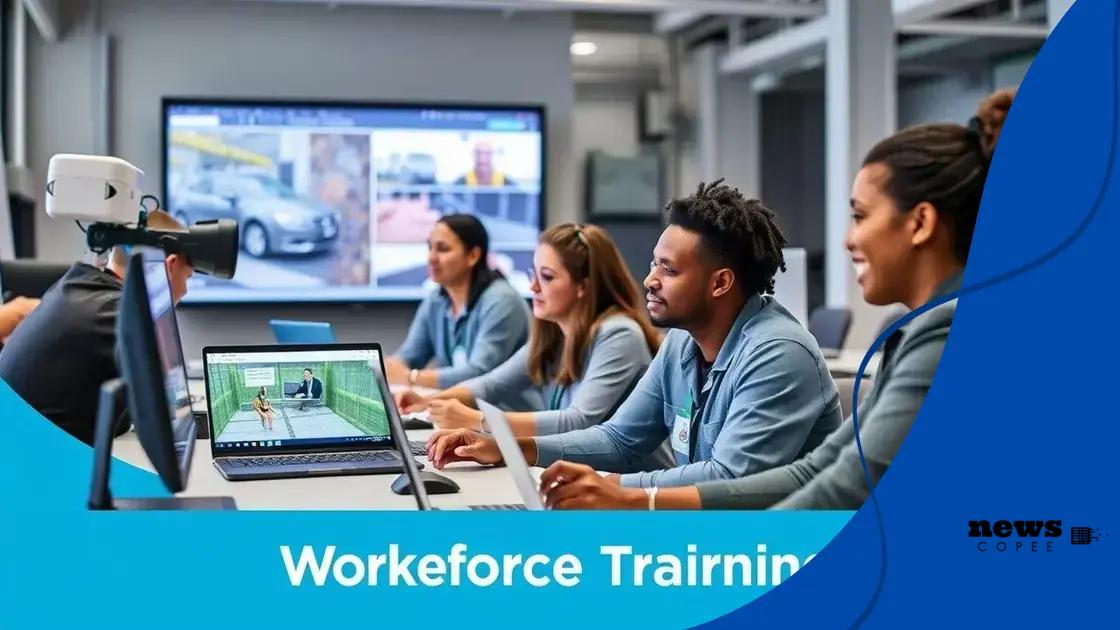Workforce development programs in 2025 launched: what’s new?

Workforce development programs launched in 2025 enhance skills and job opportunities through innovative training, government support, and technology integration, driving economic growth and community success.
Workforce development programs in 2025 launched could significantly transform how we approach skills training and employment. Are you curious about what to expect? Let’s dive into the emerging trends and opportunities ahead.
Overview of 2025 workforce development trends
Understanding the 2025 workforce development trends is essential for navigating the evolving job landscape. In recent years, changes in technology and economy have transformed how training is approached.
Key Elements Shaping Workforce Development
Several factors are influencing these trends today. First, technology plays a crucial role. The rise of artificial intelligence and automation brings new skill requirements. Many organizations are adapting by implementing tech-driven training programs to prepare workers for future challenges.
- Increased investment in online learning platforms
- Focus on soft skills alongside technical skills
- Partnerships between businesses and educational institutions
Moreover, as job markets become more global, companies must ensure that their workforce can compete internationally. This creates a demand for programs that emphasize collaboration and cross-cultural skills. Businesses are starting to realize that a diverse workforce is a major asset.
Emerging Job Roles
Another vital trend includes the creation of new job roles that did not exist a decade ago. Fields such as data analysis, cybersecurity, and renewable energy will continue to expand as sectors innovate. Training programs are being updated constantly to include these emerging fields, ensuring that workers remain competitive.
The emphasis on continuous learning is also becoming more prevalent. Many organizations are shifting towards lifelong learning models to help employees stay updated. This not only benefits the workers but also enhances organizational productivity in the long run.
In conclusion, the 2025 workforce development trends reflect a commitment to equipping individuals with the right skills, knowledge, and tools for future success. By embracing change and fostering a culture of lifelong learning, businesses and workers alike can thrive in a rapidly changing environment.
Key skills in demand for the future workforce
As we look ahead, the key skills in demand for the future workforce are becoming more apparent. With rapid advancements in technology, certain abilities are increasingly crucial for success in various fields.
Technical Skills
The demand for strong technical skills is skyrocketing. These include proficiency in software development, data analysis, and understanding of cybersecurity measures. As companies integrate new technologies, employees who can navigate these tools will be highly valued.
- Data analysis and interpretation
- Artificial intelligence and machine learning
- Cybersecurity expertise
Moreover, cloud computing is vital for businesses looking to optimize operations. Understanding how to work within cloud environments will open many doors for job seekers in 2025.
Soft Skills
While technical skills are essential, soft skills hold just as much importance. Communication, teamwork, and problem-solving abilities are critical in any workplace. Employers are searching for individuals who can collaborate effectively and adapt to changing environments.
Creative thinking is another valuable skill that stands out in future job markets. Employees who can approach challenges with innovation and originality will drive progress in their organizations.
Networking and emotional intelligence will also gain significance as businesses focus on building positive workplace cultures. These skills foster collaboration and enhance team dynamics, which are crucial for overall productivity.
In summary, those looking to thrive in the future workforce must develop a mix of both technical and soft skills. Embracing lifelong learning and staying updated on industry trends will ensure individuals remain competitive in a rapidly changing job market.
How technology shapes workforce training

Technology is changing how we approach workforce training. Companies are now using innovative tools to develop their workforce. Online courses and virtual classrooms are becoming standard, making training more accessible to everyone.
Innovative Training Tools
With the help of technology, immersive training programs are emerging. Virtual reality (VR) and augmented reality (AR) are being used to create hands-on experiences. This allows employees to practice skills in a safe environment before applying them in real-life situations.
- Online learning platforms for self-paced study
- Gamification to boost engagement
- VR simulations for practical training
Moreover, data analytics is playing a significant role in tailoring training programs. Companies can now assess the skills employees need and adjust their training accordingly. This personalized approach helps ensure workers acquire the right abilities for their roles.
Remote Training Opportunities
The rise of remote work has also transformed workforce training. Online workshops and webinars allow employees to participate from anywhere, making it easier to balance learning with work responsibilities. This flexibility is vital in today’s busy world.
Additionally, mobile learning apps are gaining popularity. They allow workers to learn on-the-go, fitting training into their daily routines. This convenience encourages continuous professional development and keeps skills up-to-date.
As we move forward, it’s clear that technology will continue to reshape how workforce training is delivered. By embracing these advancements, organizations can create more effective and engaging training experiences for their employees.
Impact of government policies on workforce programs
The impact of government policies on workforce programs is significant and far-reaching. These policies can shape the training and development strategies that organizations implement to prepare their employees for future jobs.
Incentives for Training
Governments often provide financial incentives to companies that invest in workforce training. Grants, tax credits, and subsidies encourage businesses to develop their employees’ skills. These incentives can particularly benefit small and medium-sized enterprises, making training more accessible.
- Tax deductions for training expenses
- Grants for educational programs
- Funding for apprenticeships and internships
Such policies lead to a win-win situation. Employees gain new skills, while organizations enhance productivity and competitiveness in the market.
Standards and Regulations
Moreover, government regulations set standards for workforce training programs. These standards ensure that training is relevant and effective. When policies require specific outcomes, organizations must align their training strategies accordingly.
For example, workforce development boards may mandate that training programs address the needs of the local economy. This alignment helps ensure that the skills being taught match the jobs available in the community.
Additionally, policies that promote diversity and inclusion in training programs help create a more equitable workforce. By mandating equal access to training opportunities, governments can help underrepresented groups gain crucial skills and enter the job market.
Ultimately, the influence of government policies on workforce programs is profound. Through incentives, regulations, and standards, governments can effectively shape the skills of the workforce and drive economic growth.
Success stories from 2025 program initiatives
Success stories from 2025 program initiatives offer valuable insights into the effectiveness of workforce development efforts. These programs are reshaping industries and demonstrating how targeted training can lead to impressive outcomes.
Real-World Examples
One notable example comes from a tech company that implemented a training initiative focused on data analytics. Employees participated in a specialized boot camp designed to enhance their skills in data interpretation and software tools. As a result, the company saw a 30% increase in productivity and improved decision-making capabilities.
- Increased job placements by 40% through targeted training
- Enhanced employee engagement and morale
- Better performance in key business areas
Additionally, a healthcare organization launched a program aimed at training mid-level professionals in telehealth services. This initiative not only prepared its staff for the rise in virtual healthcare needs but also improved patient satisfaction rates significantly.
Community Impact
Programs addressing local community needs have also shown promising results. Various workforce training programs have been established in partnership with community colleges. These initiatives focus on teaching essential skills like coding, trades, and business management. Participants often report feeling more qualified for jobs and have increased their employability.
Furthermore, many of these participants experience improved wages and job security. Success stories highlight individuals who transitioned from low-income jobs to rewarding careers, drastically changing their lives.
The impact of these 2025 program initiatives is undeniable. They not only reflect the potential of workforce development but also inspire other organizations to invest in their employees and communities.
FAQ – Frequently Asked Questions about Workforce Development Programs in 2025
What are workforce development programs?
Workforce development programs are initiatives designed to enhance the skills and employability of individuals through training and education.
How do government policies impact these programs?
Government policies provide funding, incentives, and regulations that can enhance and support workforce development initiatives, leading to better employment outcomes.
What role does technology play in workforce training?
Technology is reshaping workforce training by offering online courses, virtual reality simulations, and other innovative tools to improve learning experiences.
Can success stories from these programs really make a difference?
Yes, success stories provide inspiration and demonstrate the effectiveness of workforce development initiatives, encouraging further investment and participation.
